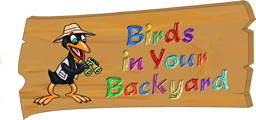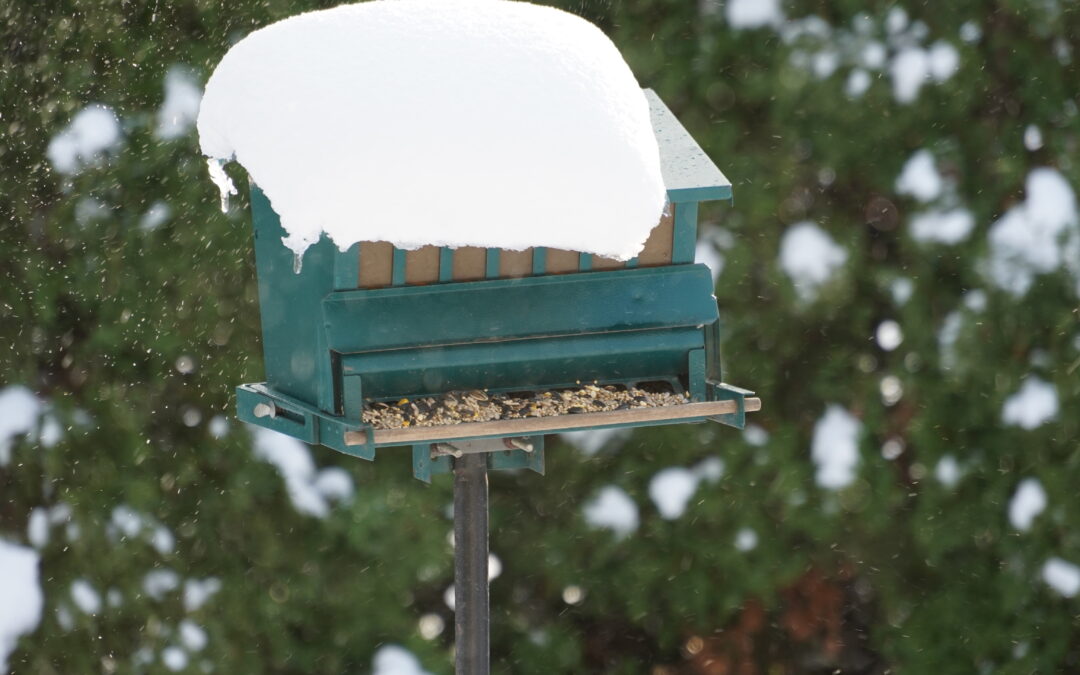Hi everyone! Welcome back to the blog where I’ve been documenting my experiences watching
birds in my backyard. This week brought lots of snowy weather and cold days. The winter
wonderland has made bird watching even more fascinating as I begin to observe the birds in
snow.
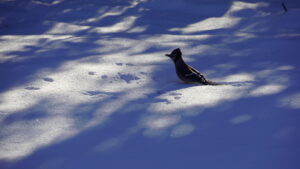
The snowy weather is excellent for watching birds at my feeder because they know I have a
reliable supply of food for them. I’ve noticed that each regular visitor has a preferred time to
come and visit. I’ve been seeing House Sparrows first thing in the morning, Black-capped
Chickadees before lunchtime, Dark-eyed Juncos in the early afternoon and Red-breasted
Nuthatches a little later in the day. There are many other birds in my backyard who don’t make
use of the feeder but spend time in the surrounding trees, plants and on the ground. The
routines have become familiar to me over the past few weeks and I look forward to the parade
of visitors to my little feeder and in the trees outside my window. I have been taking the time to
listen carefully to the sounds they make in order to work on my bird sound identification skills. I
hope that slowly I will come to know which birds are at my feeder by the sounds I can hear. It
takes a trained ear to differentiate from the multitudes of unique bird sounds and songs, and
building this skill takes time and patience. Usually when feeding I can hear the birds make small
chirps and cheeps. It is more common for the songbirds to sing when they are in the trees away
from the feeders, however, I’ve noticed that birds have been singing less since fall began to
transition into winter. Hopefully by beginning my listening practice now, I will really be able to
notice the differences in a few months as winter transitions into spring.
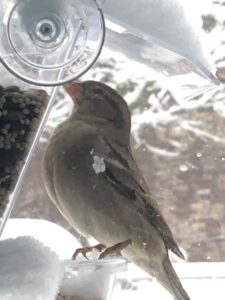
This morning after a heavy snow I observed a female House Sparrow digging through the snowy
layer on my feeder to retrieve her seeds from below. My feeder is not ideal for winter because
it doesn’t have a broad enough cover to protect from snow accumulation on the seed tray, but I
went outside to remove the snow so that all of my visitors could access the seeds on this cold
day. I spread some seed on the ground as well for the Mourning Doves who sometimes visit in
late afternoon. A little later, much to my surprise, I heard a commotion outside and saw six
Crows eating up the scattered seeds. I usually see Crows in the trees and flying above but they
seldom land in my backyard. Now that the plant matter is buried in snow and the busy insects
have gone into winter hiding birds have to get creative with their foraging behaviours. I’ve been
wondering if the birds take a tour of all the backyard feeders in my neighbourhood one after
the next. I wish I could fly with them to see how they spend their days.
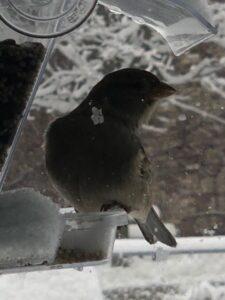
Today my journal entry is about the House Sparrow who was digging in the snowy feeder. She
had a yellowy-orange beak, soft brown plumage with dark streaks on her wings and a striped
eye marking. I noticed that she was one of many House Sparrows in the backyard, with many
more hopping, playing and chasing each other through the bushes close by. They
communicated with short chirps and moved rapidly from branch to branch. When resting they
seemed content to stay in their big group. This indicates that they are a social species. I counted
about twelve males and females in the same small bush. They also seemed to compete with
one another for the scattered ground seed. Although I have seen many birds take turns at the
feeder, the House Sparrows often roughhouse, nudging each other out of the way or trying to
crowd the feeder. I learned that House Sparrows always live in close proximity to humans and
are even a common sight in backyards where there is no feeder present. This explains why they
are one of the most familiar birds to me. Even though they are not a rare sight to behold, the
House Sparrow is an undeniable presence in our home environments and so deserve the same
careful observation in our journals. They are also an excellent example of birds whose
appearance clearly shows whether they are male or female. Male House Sparrows look much
different than females. Most males have a brown head with a grey cap, white cheeks and black
throat/bib. Their stomachs are soft grey, and their wings are striped with black and brown.

With all of this activity I have been gathering so much information in my bird journal. How is
yours coming along? In the next few weeks I am hoping to begin categorizing some of the
behaviours I’ve observed and collect more information about similarities and differences
among species. The more information we collect, the more we can begin to distinguish
patterns that tell us even more about the birds in our backyards. Snowy weather is a great time
to make observations and collect data about plumage colouration and the tracks left by their
feet and wings in the snow. We should also be able to notice some changes to their feathers as
breeding season arrives with careful observation of what they look like now so that we can
make comparisons in the future.
I hope you’ve been able to spot some birds in your backyard and that you are learning more
every day from your backyard studies. Stay tuned, because next week we will be talking about
what we can do with our everyday observations and how we can contribute to the science of
birds. Until then, happy birding!
